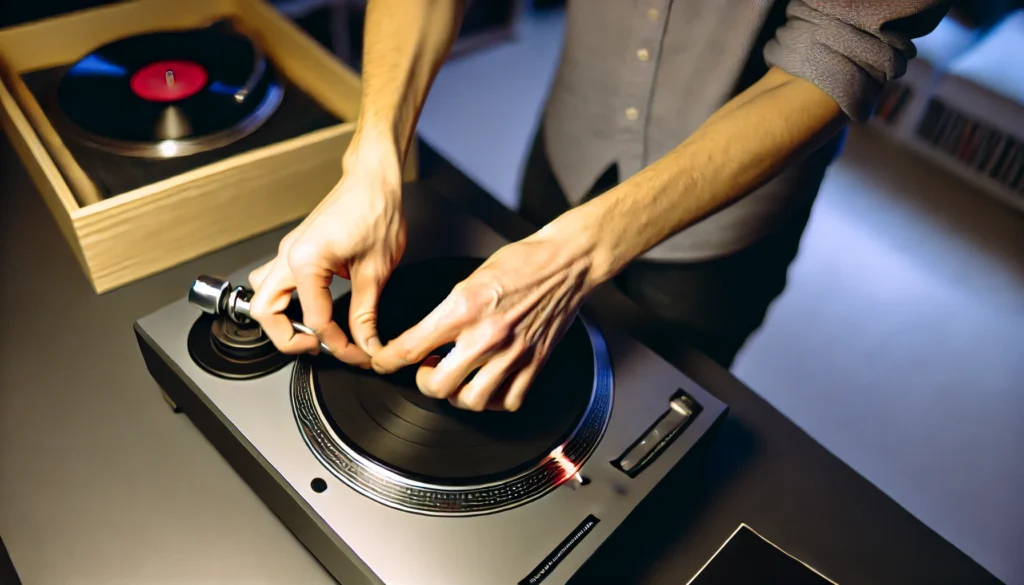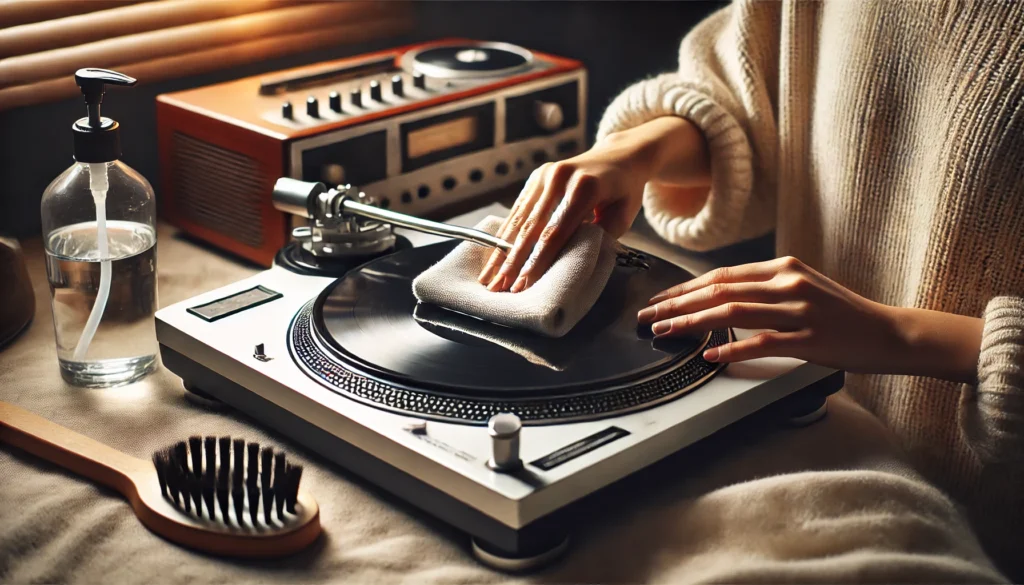Hey there, fellow vinyl lovers! Today, we’re diving into a topic that might seem a bit daunting at first: how to remove a turntable platter.
Trust me, I’ve been there – staring at my prized turntable, sweating bullets at the thought of messing something up.
But fear not! I’m here to share all the tricks I’ve learned over the years, so you can tackle this task with confidence.
Let’s kick things off with a little fun fact: did you know that the first turntable, invented by Emile Berliner in 1887, didn’t even have a removable platter? We’ve come a long way since then!
Now, removing the platter is a crucial skill for any serious vinyl enthusiast. Whether you’re doing some deep cleaning, replacing parts, or just satisfying your curiosity, knowing how to safely remove and replace your turntable’s platter is essential.
So, grab a cup of coffee (or your beverage of choice), and let’s get our hands dirty – figuratively speaking, of course. We want those platters clean, after all!
How To Remove A Turntable Platter

As a vinyl enthusiast who’s tinkered with countless turntables, I can tell you that removing a turntable platter isn’t rocket science, but it does require some care. Generally, you’ll start by removing the slipmat, then locate the center spindle.
Many platters can be lifted straight up, while others might have a locking mechanism or require a gentle rocking motion to release. The key is to be patient and never force it – if you meet resistance, stop and consult your turntable’s manual.
We’ll dive deeper into the specifics below, but remember, each turntable model can be a bit different, so always approach with caution!
Understanding Your Turntable’s Platter

Alright, let’s start with the basics – what the heck is a turntable platter anyway? Well, it’s that big circular thing your records sit on. Simple, right?
But oh boy, there’s more to it than meets the eye!
The platter is like the heart of your turntable. It’s responsible for spinning your precious vinyl at a consistent speed, which is crucial for getting that perfect sound we all crave.
I remember when I first got into vinyl, I thought all platters were the same. Man, was I wrong!
There are different types, materials, and designs, each with its own quirks and benefits. You’ve got your basic aluminum platters, which are light and get the job done.
Then there are the heavyweight champs – the acrylic and glass platters. These bad boys add some serious mass, which can help dampen vibrations.
I once upgraded to an acrylic platter and let me tell you, the difference in sound was like night and day!
But here’s the thing – removing the platter isn’t just about satisfying your curiosity (though that’s a perfectly valid reason in my book). It’s a crucial step in maintaining your turntable.
You might need to remove it to clean underneath, replace the belt on a belt-drive turntable, or even upgrade to a fancy new platter. Just remember, your platter and the bearing it sits on are precision-engineered parts.
Treat ’em with respect! I learned this the hard way when I once carelessly yanked off a platter and ended up misaligning the whole darn thing.
Spent hours getting it back to perfect – not fun, let me tell you!
So, whether you’re rocking a vintage Technics or a modern Pro-Ject, understanding your platter is the first step to turntable mastery. And trust me, once you get comfortable with this, you’ll feel like a real vinyl guru.
Just don’t let it go to your head – we’ve all got more to learn in this awesome world of analog audio!
Tools You’ll Need for Platter Removal

Alright, folks, let’s talk tools! Now, before you go raiding your toolbox like a kid in a candy store, let me tell you – when it comes to removing a turntable platter, less is often more.
But having the right tools can make all the difference between a smooth operation and a hair-pulling frustration fest. Trust me, I’ve been there!
First things first, you’ll need a clean, soft cloth. This isn’t just for wiping your brow when you start sweating bullets (kidding… sort of).
It’s actually for handling the platter once you’ve removed it. You don’t want your greasy mitts all over that precision surface, do you?
I once made that mistake and spent the next hour meticulously cleaning fingerprints off my platter. Not. Fun.
Next up, you might need a screwdriver. Now, don’t go grabbing that rusty old thing from the back of your junk drawer.
We’re talking precision here, people! A small flathead or Phillips head screwdriver (depending on your turntable) can be crucial for removing any screws holding the platter in place.
I remember the time I tried using a butter knife instead… let’s just say my turntable (and my pride) never quite recovered.
For some turntables, especially those finicky belt-drive models, you might need a pair of plastic tweezers. These are great for safely removing the drive belt without stretching or damaging it.
Metal tweezers? Forget about it!
That’s a one-way ticket to Snapped Belt City, population: you. Now, here’s a pro tip: get yourself a small flashlight.
You’d be surprised how handy this can be when you’re peering into the dark recesses of your turntable, trying to figure out what’s what. I can’t tell you how many times I’ve wished for a third hand to hold a light while I’m working.
Oh, and don’t forget about safety! A pair of lint-free gloves can be a game-changer.
They’ll protect both your hands and your equipment. I learned this the hard way after a particularly nasty encounter with some old, gummy lubricant.
Took days to get that stuff off my hands!
Lastly, and this might sound obvious, but make sure you have your turntable’s manual handy. Every model is different, and the manual can be a lifesaver when you’re trying to figure out the quirks of your particular setup.
Can’t find your manual? No worries!
Most manufacturers have them available online these days. Remember, folks, the right tools make the job easier and safer.
But hey, if you’re feeling overwhelmed, don’t sweat it! We’ve all been there.
Just take a deep breath, put on your favorite record (before you remove the platter, of course), and dive in. You’ve got this!
Step-by-Step Guide to Removing a Turntable Platter

Alright, vinyl junkies, it’s time for the main event! We’re gonna walk through removing that platter step by step.
Don’t worry, I’ll hold your hand through this (figuratively, of course – I learned the hard way that literal hand-holding and delicate audio equipment don’t mix well).
First things first, let’s prep our workspace. Clear off a flat, stable surface – your platter’s gonna need somewhere to rest once we get it off.
Lay down a soft cloth to protect it. Trust me, you don’t want to be the person who successfully removes their platter only to scratch it on a stray thumbtack.
Not that I’m speaking from experience or anything…
Now, power down your turntable and unplug it. I know, I know, you’re excited to get started, but safety first!
I once forgot this step and let’s just say, static electricity and I are no longer on speaking terms.
Okay, deep breath. We’re going in!
Start by removing the slipmat if you have one. Easy peasy, right?
But wait! Before you go yanking on that platter, take a good look at it.
Some turntables have a simple setup where the platter lifts straight off, while others might have locking mechanisms or screws holding it in place.
If you’ve got a belt-drive turntable, you’ll probably need to remove the belt first. This is where those plastic tweezers come in handy.
Gently lift the outer edge of the platter and carefully remove the belt. Whatever you do, don’t use your fingernails!
I learned that lesson the hard way – took weeks for my nail to grow back.
For direct-drive turntables, you’re usually dealing with a straight lift-off situation. But here’s the kicker – some high-end models have a locking mechanism.
If you try to yank it off without disengaging the lock, well… let’s just say you’ll be in for a world of hurt (and possibly a hefty repair bill).
Once you’ve dealt with any locking mechanisms or belts, it’s time for the moment of truth. Grip the platter firmly (but not too firmly – we’re not trying to strangle it) and lift straight up.
If it doesn’t budge, don’t force it! That’s a one-way ticket to Brokesville.
Instead, try a gentle rocking motion. Sometimes platters can get a bit stuck, especially if they haven’t been removed in a while.
As the platter comes free, be prepared for its weight. Some of these bad boys are heavier than they look!
I once nearly dropped my first high-end platter – talk about a heart-stopping moment!
And voila! You’ve done it!
Your platter is free, and you’re officially a turntable tinkerer. Take a moment to bask in your awesomeness.
But don’t get too cocky – we still need to put it back on later!
Remember, every turntable is a bit different, so if you run into any snags, don’t be afraid to consult that manual. And hey, if all else fails, there’s no shame in calling in a pro.
Better safe than sorry when it comes to your precious vinyl setup!
Common Challenges and How to Overcome Them

Alright, audio adventurers, let’s talk about the elephant in the room – or should I say, the stubborn platter on the turntable. Sometimes, removing a platter isn’t as smooth as butter on a hot pancake.
But don’t worry, I’ve been there, done that, and I’m here to share my battle scars… I mean, wisdom!
First up, the dreaded stuck platter. Oh boy, I remember the first time I encountered one of these.
I pulled, I pushed, I may have even tried sweet-talking it (spoiler alert: platters don’t respond to flattery). If you find yourself in this situation, resist the urge to channel your inner Hercules.
Brute force is a one-way ticket to Regretsville, population: you and your broken turntable.
Instead, try this little trick I learned: apply a gentle, even pressure while slowly rotating the platter. Sometimes, this can help break the seal that’s keeping it stuck.
If that doesn’t work, a little heat can be your friend. No, I don’t mean take a blowtorch to it!
(Please, for the love of vinyl, don’t do that.) Try playing a record for about 15 minutes.
The heat from operation can sometimes expand the metal just enough to loosen things up.
Now, let’s talk about those delicate vintage turntables. These babies require a special touch.
I once approached a 1960s Garrard like it was a modern deck and… well, let’s just say I gained a newfound appreciation for the phrase “they don’t make ’em like they used to.” With older turntables, patience is your best friend.
Go slow, be gentle, and if something doesn’t feel right, stop and reassess.
Another common hiccup is dealing with strange noises or resistance when trying to remove the platter. If you hear grinding, scraping, or any noise that makes you wince, stop immediately!
This could be a sign of debris caught in the bearing, or worse, a damaged bearing. I learned this lesson the hard way and ended up with a repair bill that made my wallet cry.
One more thing – be prepared for surprises. I once removed a platter and found a small colony of dust bunnies living underneath.
Another time, I discovered a long-lost guitar pick that had somehow found its way into the turntable (still not sure how that happened). The point is, expect the unexpected!
Remember, if you’re ever in doubt, there’s no shame in stepping back and seeking help. Whether it’s consulting online forums, calling the manufacturer, or taking it to a pro, sometimes discretion is the better part of valor.
Your turntable (and your sanity) will thank you.
And hey, if all else fails and you find yourself stuck (pun intended), take a break, put on your favorite record (on another turntable, of course), and come back to it later. Sometimes, a fresh perspective is all you need to overcome these platter predicaments.
You’ve got this, vinyl warrior!
Cleaning and Maintaining Your Platter
Alright, vinyl virtuosos, we’ve made it to the final frontier – the art of platter pampering! Now that you’ve successfully removed your platter (high five!), it’s time to show it some love.
Trust me, a clean, well-maintained platter is the secret sauce to audio nirvana.
First things first, let’s talk about why this is important. Your platter is like the foundation of a house – if it’s not level and smooth, everything built on top of it is gonna be wonky.
I learned this the hard way when I ignored a seemingly innocent bit of gunk on my platter. The result?
More pops and crackles than a bowl of Rice Krispies. Not exactly the audiophile experience I was going for!
So, how do we keep our platters pristine? Well, start with a gentle cleaning.
And when I say gentle, I mean it! No harsh chemicals or abrasive materials here.
I once made the mistake of using an old t-shirt to clean my platter. Let’s just say, my “AC/DC” logo is now permanently etched into the surface.
Not my finest moment.
Instead, use a soft, lint-free cloth slightly dampened with distilled water. If you’re dealing with stubborn grime, a tiny drop of mild dish soap can help, but be sure to rinse thoroughly.
Work in gentle circular motions, paying extra attention to any visible marks or smudges.
Now, here’s a pro tip: don’t forget about the underside of the platter! This often-neglected area can accumulate dust and debris, which can affect your turntable’s performance.
I once found an entire ecosystem of dust bunnies living under there. It was like a tiny, fuzzy civilization!
Once you’ve got your platter squeaky clean, it’s time to talk about the beating heart of the operation – the bearing. This is the part that allows your platter to spin smoothly.
A well-lubricated bearing is crucial for optimal performance. But beware!
More is not always better when it comes to bearing oil. I learned this the hard way when I over-lubricated mine and ended up with oil all over my favorite record.
Talk about a slippery situation! A tiny drop of the right oil (usually specified in your turntable’s manual) is all you need.
Apply it carefully to the spindle, and you’re golden.
Now, let’s talk about a often overlooked aspect of platter maintenance – leveling. An uneven platter can cause all sorts of issues, from inconsistent playback speed to increased wear on your records.
I once spent weeks trying to figure out why my records sounded “off,” only to realize my platter was slightly tilted. Face, meet palm!
To check if your platter is level, you can use a bubble level or even a leveling app on your smartphone. Place it on the platter and rotate it to different positions.
If you notice any significant deviations, you might need to adjust the feet of your turntable or even the surface it’s sitting on.
Oh, and here’s a tidbit that might blow your mind – temperature matters! Extreme temperatures can affect the shape of your platter, especially if it’s made of materials like acrylic.
I once left my turntable near a heater and came back to find my platter had warped ever so slightly. Lesson learned: keep your setup away from heat sources and direct sunlight.
Let’s not forget about static, the silent killer of good sound. A static-y platter can attract dust like a magnet, and we all know dust is the enemy of clean playback.
Investing in an anti-static brush or gun can work wonders. I remember the first time I used an anti-static gun – it was like magic!
Suddenly, dust wasn’t clinging to my records like a clingy ex.
Lastly, consider the material of your platter mat. Whether you’re team felt, rubber, or cork, make sure to give it a good cleaning regularly too.
These mats can trap a surprising amount of dust and debris. I once found a small forest of cat hair living in my felt mat (note to self: keep the turntable cover closed when not in use).
Remember, folks, a little bit of regular maintenance goes a long way. It might seem like a chore at first, but trust me, your ears will thank you.
And hey, there’s something oddly satisfying about giving your beloved turntable some TLC. It’s like a bonding experience between you and your music!
So there you have it – the ins and outs of platter cleaning and maintenance. With these tips, your platter will be spinning smoother than a Barry White love song.
And hey, there’s something oddly satisfying about giving your beloved turntable some TLC. It’s like a bonding experience between you and your music!
So there you have it – the ins and outs of platter cleaning and maintenance. With these tips, your platter will be spinning smoother than a Barry White love song.
Now, go forth and enjoy that crystal-clear analog sound!
Conclusion
Whew! We’ve come a long way, haven’t we? From understanding what a platter is to becoming bona fide platter removal experts, we’ve covered it all.
And let me tell you, if you’ve made it this far, you’re well on your way to becoming a true vinyl virtuoso!
Remember when we started, and the idea of removing a turntable platter seemed as daunting as defusing a bomb? (Okay, maybe that’s a bit dramatic, but you get the point!) Now look at you – armed with knowledge, ready to tackle any platter that dares cross your path.
It’s like we’ve been on a journey together, you and I, through the highs and lows of turntable maintenance.
But here’s the thing – and I can’t stress this enough – every turntable is unique. What works for my vintage Technics might not be the ticket for your shiny new Pro-Ject.
So don’t be afraid to customize these tips to fit your specific setup. Experiment, but always err on the side of caution.
Trust me, I’ve learned the hard way that sometimes, less really is more when it comes to tinkering with audio equipment.
Now, I know we’ve covered a lot of ground here, but don’t let it overwhelm you. Rome wasn’t built in a day, and neither is turntable expertise.
Take it one step at a time, and before you know it, you’ll be removing platters in your sleep! (Though I wouldn’t recommend actually doing that – sleepwalking and delicate audio equipment don’t mix, trust me on this one.)
Oh, and let’s not forget about safety. Always prioritize the well-being of both yourself and your precious equipment.
If something doesn’t feel right, or if you’re unsure, there’s no shame in seeking help from a professional. Better safe than sorry, especially when it comes to your beloved vinyl setup.
As we wrap up this vinyl voyage, I want to encourage you to share your own experiences and tips. Every vinyl enthusiast has their own tricks of the trade, and the community thrives on sharing knowledge.
So don’t be shy – drop a comment below and let us know about your platter removal adventures!
And hey, if you found this guide helpful, why not spread the love? Share it with your fellow vinyl junkies.
After all, good music (and good advice) is meant to be shared.
So, my fellow audiophiles, it’s time to put this newfound knowledge to the test. Go forth and remove those platters, clean those bearings, and bask in the glory of a well-maintained turntable.
Your records (and your ears) will thank you.
Until next time, keep those grooves clean and your music flowing. Happy spinning, everyone!
